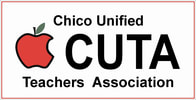|
Hello colleagues,
Your CUTA bargaining team and the District met for negotiations on Thursday, January 16. We continued discussing special education, innovative scheduling at the high school, compensation and a host of other issues as well. Special Education We continued discussing the District’s plan to allow mild/moderate SDC secondary teachers to volunteer to become RSP teachers. In this plan, all of the mild/moderate SDC and RSP students would be blended into one group of students simply called mild/moderate students when they exit elementary school and enter middle school. Any mild/moderate SDC secondary teachers who wish to remain in their positions would be able to with no changes to their job. Those who volunteer to become RSP teachers would have a caseload of 28 students from the blended pool. Current RSP teachers could be impacted in terms of the classes they teach and the sizes of their classes. CUTA is negotiating specifics of the District’s plan, including maximum class sizes, potential changes to caseload maximums, and a guarantee of protection for teachers who don’t volunteer for the change. The District will continue to hold voluntary meetings for potentially impacted teachers, and these meetings have already generated excellent questions, which CUTA shared with the District yesterday The District has not shared a date when they would ask for teachers to make the decision to volunteer, because they recognize that more planning and information is needed. CUTA believes the specifics of the new model need to be negotiated before members should volunteer. We will continue negotiations in February. Innovative Scheduling at the High Schools We began to work on the negotiable issues related to the proposed block schedule at the high schools. Once the negotiated issues have been settled, the final plan will go back to the high schools for a vote to approve or not. If the final plan achieves a two-thirds approval vote at both high schools, the plan will go to E-Board for approval. If E-Board approves the plan, it will go into the next tentative agreement along with other negotiated items unrelated to innovative scheduling, which will be voted on by all members. Negotiable items discussed on Wednesday included (in no particular order): Item Status Start time This will be dictated by the new law saying high school must start at 8:30 or later. If the new law does not go into effect, start times at both schools will likely not change. Prep time for general education A teacher will receive two preps during the eight period block; the preps will be on different days unless mutually agreed to by the member and the administrator. Prep time for special education CUTA advocated for special education teachers to receive three non-teaching periods during the eight period block; negotiations are continuing. Maximum class size Still negotiating Total student contacts Still negotiating 6/5ths language If a teacher agreed to teach a seventh class because of site need, he or she would receive pay commensurate to 7/6ths of his or her salary. If a teacher agreed to teach a seventh and an eighth class, he or she would receive pay commensurate to 8/6ths of his or her salary. Teaching minutes in a day Still negotiating Collaboration The scheduling of collaboration time would be embedded in the contract language for the block schedule with the existing waiver language describing the purpose of collaboration time and the fact that it is teacher-driven. Transfer language If the block schedule becomes a reality, high school teachers at PV and Chico High would have first rights to transfer out of comprehensive high schools to other open positions that they are credentialed for and an interview process would govern decisions in the case of multiple candidates. Sunset clause Innovative scheduling would have a five-year sunset clause, which means that after four years, it would automatically reopen for negotiations. CUTA or the District could choose to end innovative scheduling at that time, or they could negotiate for it to continue. Flexible implementation year If innovative scheduling was adopted, the District could delay implementation for one year (from 2021-22 to 2022-23) if required by budgetary constraints. Finals schedule Still negotiating We will continue our discussions in February at our next session and after the two voluntary informational meetings scheduled for February 3 (CHS Lincoln Hall at 3:15 pm) and February 10 (PVHS Library at 3:00 pm). New Teacher Induction Program Costs The state has increased the new teacher induction program from a one-year requirement to a two-year requirement and has also increased the tuition cost from $3,000 to $3,600, for a total cost to new teachers of $7,200. This is an extreme hardship for many new teachers, who are often already saddled with student loans. Several years ago, the District offered to pay $3,000 towards the tuition cost. At the time, this covered the entire cost of the then one-year program. The District then offered to pay $1,500 of the cost “up front” to the new teacher induction program at the Butte County Office of Education to further help our new teachers. I want to be clear that the District came to CUTA and made these generous offers, which we were happy to negotiate. This increased cost comes at an unfortunate time, when money is tight in the District. Nonetheless, we are working with the District to try to alleviate this burden on new teachers. When I talked to BCOE about the induction program, they said that they are sometimes able to get grant money to reduce the tuition cost, but it is not guaranteed. We will also be looking at how surrounding districts are managing this increased cost to new teachers. If you’d like to see the current version of our contract, here is the link. Thank you for taking the time to stay informed. Charlie Snyder Bargaining Chair Chico Unified Teachers Association
0 Comments
Hello colleagues,
Your CUTA team and the District met for negotiations on Thursday, January 16. We continued discussing special education, innovative scheduling at the high school, compensation and a host of other issues as well. Special Education The District shared their vision for significant change in the secondary mild/moderate special education program. In an effort to provide what they feel is the best program for students and in an effort to save money in the long term, the District plans to combine secondary mild/moderate SDC students and RSP students into one large pool of mild/moderate students. As students leave elementary school, there will no longer be a distinction between the two groups of students. The students will still receive everything allotted them by their IEPs, but they will not be identified as mild/moderate SDC students or RSP students. They will simply be considered mild/moderate special education students. As part of this new approach, the District will offer secondary mild/moderate SDC teachers the option to become RSP teachers. If a mild/moderate SDC teacher chooses to become an RSP teacher, she or he will have a caseload maximum of 28 (up from 20 in junior high and 22 in high school) and she or he will teach four periods and have on prep period and one assessment period. If a mild/moderate SDC teacher chooses to remain in her or his current position, nothing will change in terms of caseload, class size and teaching load; however, if some members of a site SDC team do choose to change and others don’t, it will necessarily have an impact on what subjects the remaining SDC teacher(s) will teach. Secondary sites will identify what classes are needed for the broader pool of mild/moderate students, and all the RSP teachers will need to teach the classes determined to be needed. The District hopes that RSP teachers at each site will work together to decide how best to split up teaching responsibilities. If a significant number of secondary mild/moderate SDC teachers choose to become RSP teachers, it is very likely that current RSP teachers will need to teach different classes in the future than they are accustomed to. How this will impact co-teaching and push-in support is still to be determined. The District first shared this idea with some of the affected teachers at a collaboration meeting a week ago, and they plan to hold more informational meetings in the near future so that mild/moderate SDC teachers can make an informed decision. Although your CUTA bargaining team shares an interest with the District in increasing the efficiency of the special education program and in providing relief to our special education teachers, we are troubled by this approach. There are so many unknowns, and it will have a significant, potentially negative, impact on current RSP teachers. Whether the potential benefits to students will materialize is also unknown. If the majority of secondary mild/moderate SDC teachers choose to become RSP teachers, it will save the District money, because they will need fewer teachers to handle the student load. The District has assured CUTA that they plan to reduce teaching positions through attrition rather than through layoffs, and we will work on language to guarantee that. We will also negotiate an RSP maximum class size, which is currently not part of the contract. Additionally, CUTA cannot stop the District from offering this option to secondary mild/moderate SDC teachers, and the District has the contractual right to reassign RSP teachers to different subjects/classes. If you are an affected member, and if possible, please attend the voluntary informational meetings when they are scheduled by the District. The union will have representation at these meetings as well, when possible, so that you can share your thoughts. Innovative Scheduling at the High Schools Below is an updated list describing the current stage of the process towards potentially changing to a new schedule at the high schools.
Simple majority vote to send to negotiations: 132 ballots cast 2 abstentions 88 Yes 67.7% 42 No 32.3%
|
AuthorSMary Schoenthaler serves as Vice President and Public Relations Chair for CUTA. Archives
April 2021
Categories |
Hours2:30pm-5:00pm Monday-Friday
Summer Hours 1:00-5:00p.m. or by Appointment Tuesday-Thursday |
Telephone(530) 343-0226
Charlie Snyder's Cell Phone (530) 321-8637 |
Contact Us |

 RSS Feed
RSS Feed

